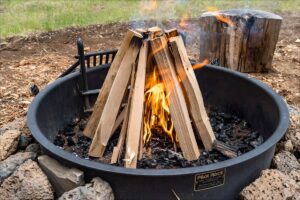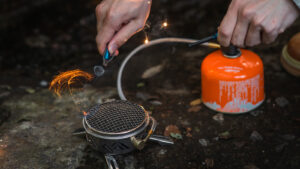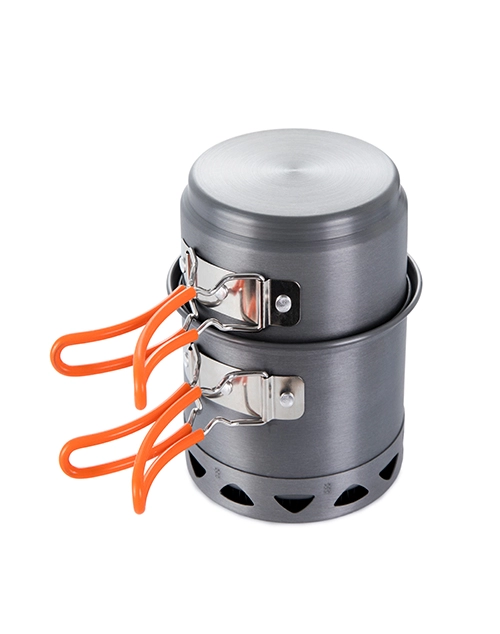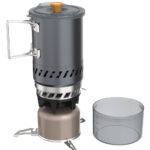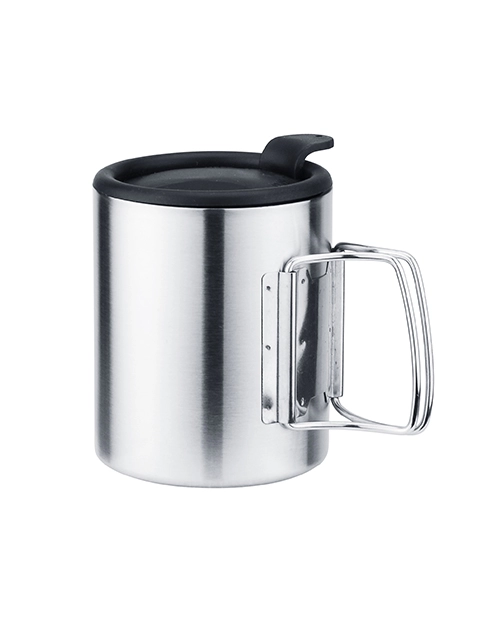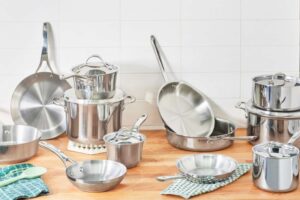
What Is Stainless Steel Cookware?
Stainless steel is an alloy of iron, carbon, and other metals such as chromium that adds a passive layer of protection to the material’s surface. It may also comprise additional metals added to get the required qualities.
To be considered ‘ stainless,’ the steel alloy must contain at least 10% chromium by weight. Chromium is responsible for this material’s non-corrosive properties and the metal’s longer lifespan. Stainless steel pots and pans are popular among home cooks and professional chefs throughout the world due to their ease of cleaning, robustness, and corrosion resistance. But with stainless steel cookware, it is important to understand that quality is everything. Not all pots and pans made of this material will have the same features; some are safer, environmentally friendly, and more durable than others. To establish whether or not it poses a health concern, we must first consider the type of stainless steel used in terms of material composition and alloy properties.
Types Of Stainless-Steel Cookware
Since stainless steel is an alloy, it is essential to examine its composition if you want to learn more about it. Stainless steel is classified into distinct sorts or grades based on its structure and alloy composition.
When researching and purchasing stainless steel pans or other cookware, you will often notice a number indicating the grade you are looking at. Looking at the number might help you discover the exact composition of the item. The most often used grade of stainless steel in cookware is austenitic stainless steel in the 300 series, specifically type 304. Austenitic stainless steel is one of the five types of this material. It is distinguished by its crystalline structure. This structure is obtained by including stabilizing components like nickel, manganese, and nitrogen into the mix. Austenitic stainless steels in the 300 series are generally formed by adding nickel.
304 Stainless Steel
As mentioned earlier, 304 stainless steel is the most often used grade for stainless steel pots and pans, cutlery, and other kitchen equipment.
This grade of stainless steel is sometimes known as 18/10 or 18/8 stainless steel. These figures indicate the alloy’s chromium and nickel content. So, cookware made from this grade of stainless steel has 18% chromium and either 10% or 8% nickel. The nickel component makes stainless steel more corrosion-resistant. However, adding nickel increases the material’s cost, therefore stainless-steel cookware sets manufactured with this grade are often the most expensive.
30 Stainless Steel
Another type of stainless steel that is widely used for cookware is 430. This is sometimes referred to as 18/0. So, while it does contain chromium, it is nickel-free.
This is a ferritic stainless steel and so magnetic, as opposed to the above, which is not magnetic. It may, however, be magnetized for extended periods of time using electricity. Because this type of cookware lacks nickel, it is less corrosion-resistant and will last less time than the ones listed above. However, because this is a low-cost grade, it is frequently utilized in less priced stainless steel kitchen appliances.
What Kind of Stainless Steel Is Non-Toxic?
First, let us consider if the cooking surface of stainless-steel cookware is non-toxic. The good news is that stainless steel is regarded food-safe and non-toxic if the alloy includes at least 16% chromium. This chromium concentration guarantees that the cooking surface is hard and non-reactive, preventing germs from residing there and heavy metals from interacting excessively with the food.
However, it is crucial to note that when you use stainless steel cookware, minute amounts of chromium and nickel are released into the meal.
How To Care for Stainless Steel Cookware
Treat your pans with care to ensure their safety and longevity of usage. Avoid exposing your pots and pans to thermal shock (such as placing hot pans on cold surfaces). Also, follow the manufacturer’s directions to see how high temperatures may go before warping, damage, or other concerns develop.
- Clean stainless-steel pots and pans after use using natural soap and a non-abrasive sponge or cloth.
- To remove burned food or obstinate things, boil water with baking soda.
- To eliminate discoloration from stainless steel pots and pans, wipe them with vinegar.
- Dry pans thoroughly before hanging or storing them.
The benefits of stainless-steel cookware
- Stainless steel is an excellent choice for non-toxic, long-lasting, and sturdy cookware suitable for boiling, sautéing, and baking. It is ideal for small-batch baking since it holds heat effectively and cooks’ food evenly.
- Stainless steel is also simple to clean and maintain, making it ideal for inexperienced chefs, such as students living away from home for the first time. Simply clean with hot soapy water after each use, or scrape down with steel wool to remove any residual oil.
- Stainless steel is a versatile material. Pots and frying pans made of stainless steel are readily available, as well as griddles, lasagna pans, roasting trays, muffin tins, and baking sheets.
Disadvantages of stainless-steel cookware
- One potential disadvantage of stainless steel is that it might leach heavy metals into food. This is more likely if you cook acidic items in a stainless-steel saucepan over an extended period of time.
- Anyone who is sensitive to nickel should look into alternatives to stainless steel. This is because, while stainless steel pans or pots with minimal or no nickel content is available, it is particularly prone to corrosion.
Is Stainless Steel Cookware Safe?
In the simplest terms, yes— It is safe to use. It’s one of the most versatile, adaptable, and low-maintenance solutions for home chefs. In terms of safety, it stands out for its nonreactivity, lightweight manoeuvrability, and remarkable heat regulation characteristics, all of which assist reduce the possibility of toxic chemical leaking, physical damage, and unintentional flare-ups.
While stainless steel is typically safe to cook with, not all stainless steel is created equally. For example, the premium-grade stainless steel we utilize in our stainless-clad cookware has a high binding strength, making chemical leaching rare. In other words, you may use our cookware without worrying about any of the building elements seeping into the completed meal.
ODM service
Looking for reliable wholesale outdoor equipment? At Deermaple, we specialize in ODM service, offering high-quality and innovative cooking gear tailored to your needs.
If you are interested in outdoor gear wholesale, please contact us.

